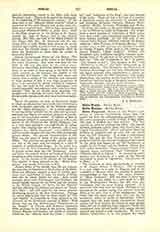

Biblia Pauperum (BIBLE OF THE POOR) a collection of pictures representing scenes from Our Lord’s life with the corresponding prophetic types. The series commonly consists of forty or fifty pages. The page is divided into nine sections. The four corners are used for explanatory texts. The central pictures represent scenes from Our Lord’s life, arranged chronologically. Above and below these are pictures of prophets and on each side are scenes from the Old Testament. It is thus a concordance of the Old and the New Testaments in which is gathered together the common tradition of the Church on the types and figures of the Old Testament, as taught by the liturgy and the Fathers. Hence they were called sometimes “Figurae typicae Veteris Testamenti atque antitypicae Novi Testamenti” or “Historia Christi in Figuris”. An interesting reproduction and description of a page on the Blessed Sacrament is given in Vigouroux, “Dictionnaire de la Bible“, s.v.
The invention of these picture-books is ascribed to St. Ansgar, Bishop of Bremen. This is stated in a note added to a copy at Hanover and in the cathedral at Bremen there are remains of pictures, corresponding to this copy. The name, however, of “Biblia Pauperum” does not seem to have been primitive. It was added by a later hand to a MS. in the Wolffenbiittel library; the MS. was thus catalogued, and the name became common. It is uncertain why they were so called. Perhaps it was because of the ancient saying that pictures were the Bible of the poor, that is, of the uneducated. Some think that the name came from their use by the mendicant orders as books of instruction. Others suppose that the term means inexpensive; manuscripts had been beyond the means of most people; when the art of printing from engraved blocks was introduced these picture-books were among the first printed and gained a wide circulation. We have no definite information as to the purpose for which these books were intended. Probably it was for religious instruction; perhaps also to serve as models for artists. It is certain that they exercised a great influence in spreading a knowledge of the mysteries of Faith, affording themes for preachers and artists. At Hirschau in Swabia, the entire series of pictures is reproduced in stained glass.
Only a few manuscript copies of the “Biblia Pauperum” are extant; they come from the school of John van Eyck (1366-1466). The block-book, or xylographic process, appeared early in the fifteenth century, and Sotheby counts seven editions made from these wooden slabs. Only one side of the paper was printed, two sheets being pasted together to make a leaf. Five copies are in the Bibliotheque Nationale: four have forty plates; one copy is colored by hand; the fifth has fifty plates. The first edition from movable types was printed by Pfister at Bamberg in 1462. The earlier editions have Latin texts; later they were printed in the vernacular. A German “Armenbibel” was published in 1470, and at Paris in 1503, A. Verard published “Les Figures du Vieil Testament et du Nouveau”. In some of the printed editions the original arrangement of pictures and texts was modified. In the latter half of the fifteenth century these books were very popular. As improved methods made it possible to issue the whole Bible with illustrations, the “Biblia” fell into disuse and disappeared. Several facsimile reproductions have appeared with historical and bibliographical introductions notably by Berjeau (1859); Camesina and Heider (Vienna, 1863); Unwin (London, 1884), with introduction by Dean Stanley; Einsle (Vienna, 1890); Laib and Schwarz (1892) and P. Heitz (1902).
JOHN CORBETT

